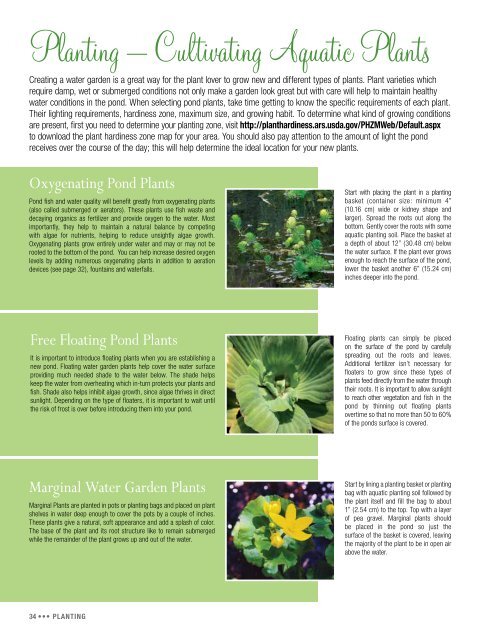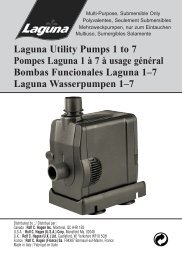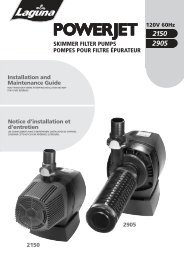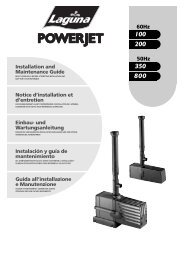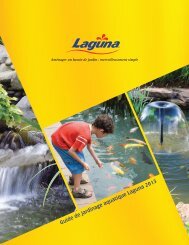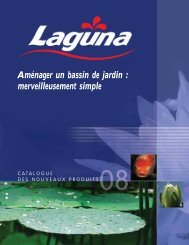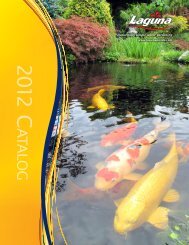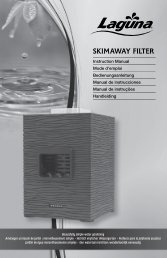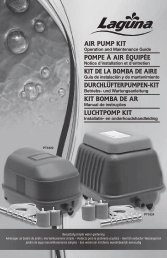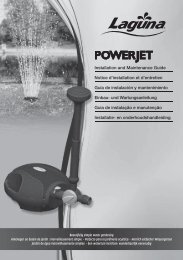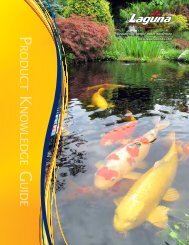Laguna - 2013 Guide to Water Gardening - Lagunaponds.com
Laguna - 2013 Guide to Water Gardening - Lagunaponds.com
Laguna - 2013 Guide to Water Gardening - Lagunaponds.com
Create successful ePaper yourself
Turn your PDF publications into a flip-book with our unique Google optimized e-Paper software.
Planting – Cultivating Aquatic Plants<br />
Creating a water garden is a great way for the plant lover <strong>to</strong> grow new and different types of plants. Plant varieties which<br />
require damp, wet or submerged conditions not only make a garden look great but with care will help <strong>to</strong> maintain healthy<br />
water conditions in the pond. When selecting pond plants, take time getting <strong>to</strong> know the specific requirements of each plant.<br />
Their lighting requirements, hardiness zone, maximum size, and growing habit. To determine what kind of growing conditions<br />
are present, first you need <strong>to</strong> determine your planting zone, visit http://planthardiness.ars.usda.gov/PHZMWeb/Default.aspx<br />
<strong>to</strong> download the plant hardiness zone map for your area. You should also pay attention <strong>to</strong> the amount of light the pond<br />
receives over the course of the day; this will help determine the ideal location for your new plants.<br />
Oxygenating Pond Plants<br />
Pond fish and water quality will benefit greatly from oxygenating plants<br />
(also called submerged or aera<strong>to</strong>rs). These plants use fish waste and<br />
decaying organics as fertilizer and provide oxygen <strong>to</strong> the water. Most<br />
importantly, they help <strong>to</strong> maintain a natural balance by <strong>com</strong>peting<br />
with algae for nutrients, helping <strong>to</strong> reduce unsightly algae growth.<br />
Oxygenating plants grow entirely under water and may or may not be<br />
rooted <strong>to</strong> the bot<strong>to</strong>m of the pond. You can help increase desired oxygen<br />
levels by adding numerous oxygenating plants in addition <strong>to</strong> aeration<br />
devices (see page 32), fountains and waterfalls.<br />
Start with placing the plant in a planting<br />
basket (container size: minimum 4”<br />
(10.16 cm) wide or kidney shape and<br />
larger). Spread the roots out along the<br />
bot<strong>to</strong>m. Gently cover the roots with some<br />
aquatic planting soil. Place the basket at<br />
a depth of about 12” (30.48 cm) below<br />
the water surface. If the plant ever grows<br />
enough <strong>to</strong> reach the surface of the pond,<br />
lower the basket another 6” (15.24 cm)<br />
inches deeper in<strong>to</strong> the pond.<br />
Free Floating Pond Plants<br />
It is important <strong>to</strong> introduce floating plants when you are establishing a<br />
new pond. Floating water garden plants help cover the water surface<br />
providing much needed shade <strong>to</strong> the water below. The shade helps<br />
keep the water from overheating which in-turn protects your plants and<br />
fish. Shade also helps inhibit algae growth, since algae thrives in direct<br />
sunlight. Depending on the type of floaters, it is important <strong>to</strong> wait until<br />
the risk of frost is over before introducing them in<strong>to</strong> your pond.<br />
Floating plants can simply be placed<br />
on the surface of the pond by carefully<br />
spreading out the roots and leaves.<br />
Additional fertilizer isn’t necessary for<br />
floaters <strong>to</strong> grow since these types of<br />
plants feed directly from the water through<br />
their roots. It is important <strong>to</strong> allow sunlight<br />
<strong>to</strong> reach other vegetation and fish in the<br />
pond by thinning out floating plants<br />
overtime so that no more than 50 <strong>to</strong> 60%<br />
of the ponds surface is covered.<br />
Marginal <strong>Water</strong> Garden Plants<br />
Marginal Plants are planted in pots or planting bags and placed on plant<br />
shelves in water deep enough <strong>to</strong> cover the pots by a couple of inches.<br />
These plants give a natural, soft appearance and add a splash of color.<br />
The base of the plant and its root structure like <strong>to</strong> remain submerged<br />
while the remainder of the plant grows up and out of the water.<br />
Start by lining a planting basket or planting<br />
bag with aquatic planting soil followed by<br />
the plant itself and fill the bag <strong>to</strong> about<br />
1” (2.54 cm) <strong>to</strong> the <strong>to</strong>p. Top with a layer<br />
of pea gravel. Marginal plants should<br />
be placed in the pond so just the<br />
surface of the basket is covered, leaving<br />
the majority of the plant <strong>to</strong> be in open air<br />
above the water.<br />
34 ••• planting


